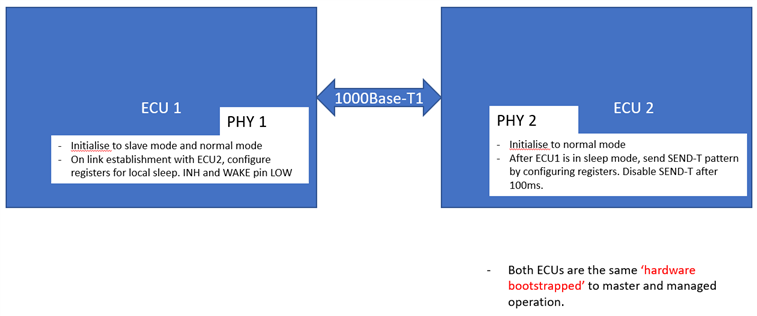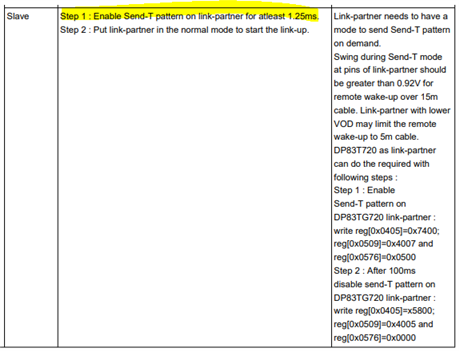Hello Team,
For a customer project, we have used the DP83TG720S-Q1 Ethernet PHY for 1000Base-T1 communication on the ECU board. The bootstrap configuration are in Master Mode and managed mode. We wanted to experiment on the sleep/wake-up functionality.
For a local or remote wake-up, the INH output pin, when triggered transition high will enable the PMIC connected and turn the power supply for the PHY and the PHY transitions to normal mode(since it is bootstrapped to managed operation)
Please correct me if I am wrong in my understanding in the below statements
1) For a local wake up, the wake pin triggers the INH pin
2) For remote wake up, the send-T pattern from remote link partner will trigger the INH pin due to the energy detection on the MDI
We want to test the sleep/wake-up functionality using two of our ECU boards. Since, the bootstap configuration is Master, we want to change one of the ECU PHY's to slave. We were able to achieve this by setting the register 0x1834 = x8001 for slave mode.
My query is when we put one of the ECUs to sleep(configured to sleep mode, using local sleep steps),
3) should we enable the energy detection bit in register 0x018B when following the steps for local sleep, if we want to later wake it up using remote wake up by remote- link partner?
4) if enable detection bit is set i.e the above step done before it goes to local sleep, for remote wake-up the send-t pattern is sent by remote link partner(master mode) will the local ECU(sleep mode) have the INH pin triggered high on send-t pattern? Or should the wake pin also be set high in the local ECU? Are there any other requirements?
5) Sometimes, when sleep mode is activated, and we transition back to normal mode, the register values are lost(as mentioned in the manual). If we do a hardware reset via register access(0x001F = x8000), the values do not reset to default values. Is there any reason for this? Or any script we can use to initialise the registers back to default value?
Looking forward to your response.
Thanks in advance
Aarathi





